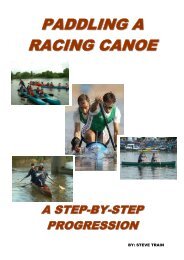The Science of Canoeing By Richard Cox
The Science of Canoeing By Richard Cox
The Science of Canoeing By Richard Cox
Create successful ePaper yourself
Turn your PDF publications into a flip-book with our unique Google optimized e-Paper software.
Differences between kayak and Canadian paddlers in any one <strong>of</strong> the above dimensions was not statistically<br />
significant although Canadian canoeists do tend to be lighter and shorter in arm length, trunk length and overall<br />
height.<br />
<strong>The</strong> relative importance <strong>of</strong> any one <strong>of</strong> these variables associated with body build is highly debatable and as long<br />
as one falls within a reasonable range <strong>of</strong> these mean norms one should not feel unduly concerned. If you are<br />
especially tall or short, ectomorphy or endomorphy, there is nothing you can do to change these features. Since<br />
you have to live with them, you can either choose a different sport to which your body build is better suited or<br />
accept that you might have to assert greater effort to achieve the same results as some <strong>of</strong> your contemporaries.<br />
Equipment and Clothing<br />
Considerable debate ensues in canoeing circles, as in most fashionable sports, about the relative merits and<br />
shortcomings <strong>of</strong> different designs/brands <strong>of</strong> equipment and clothing. Such debate is usually prompted by sales<br />
'hype' and attempted explanations as to why a particular individual is experiencing sudden success or loss <strong>of</strong><br />
form. Such debate is not always healthy, especially amongst younger and less accomplished paddlers who lose<br />
confidence in their ability to achieve success with the equipment they are using.<br />
In terms <strong>of</strong> basic equipment, that is, boat and paddle the most crucial factors to look out for have already been<br />
touched upon in earlier chapters <strong>of</strong> the book. <strong>The</strong> basic dimensions and characteristics <strong>of</strong> a racing kayak (that is<br />
the maximum length, maximum width and maximum weight- see p20) are clearly laid down by the ICF. Within<br />
these parameters, however, are an infinite range <strong>of</strong> design and construction techniques which may or may not<br />
enhance overall performance. In terms <strong>of</strong> kayak design, slenderness <strong>of</strong> the hull, shape <strong>of</strong> the cross-section and<br />
the quality <strong>of</strong> the surface finish are the most significant variables to look out for. Slenderness <strong>of</strong> the hull is<br />
important because it determines to a great extent, the wave-making resistance <strong>of</strong> a craft. <strong>The</strong> cross-sectional<br />
design <strong>of</strong> a given hull length will dictate the amount <strong>of</strong> wetted area, which as we noted in Chapter Three,<br />
influences the skin friction generated as the canoe travels through the water.<br />
Evaluation <strong>of</strong> a craft in terms <strong>of</strong> weight and construction is also straightforward. A lightly built canoe requires<br />
less power to accelerate through the water than a heavier one but at the same time is less likely to be very robust.<br />
<strong>The</strong> introduction <strong>of</strong> carbon-kevlar in the construction <strong>of</strong> racing boats has improved strength-weight ratios. It is a<br />
very light, yet strong material which does not flex in the same way as glass fibre strand or mat. As with all<br />
racing craft the surface <strong>of</strong> the hull should be hard, smooth and free from undulations in order to keep surface<br />
friction at a minimum.<br />
Many <strong>of</strong> the characteristics identified above are <strong>of</strong>ten in conflict with one another and it is the task <strong>of</strong> the<br />
designer/manufacturer to achieve the best compromise between speed, stability, strength and production costs.<br />
Because <strong>of</strong> individual characteristics and personal taste, no hierarchy can be attached to the relative importance<br />
<strong>of</strong> these variables. What is the most suitable model for one individual may not be the same as for another. A tall<br />
paddler with a



